What Is Local Business Marketing?
Local business marketing involves strategies and tactics to attract and engage customers in specific geographic areas.
This marketing approach primarily targets potential customers who are physically close to a business location. Ideal for brick-and-mortar companies like restaurants and retail stores—though nationwide and online companies can also benefit from it.
Local marketing is critical if you’re a small business owner looking to drive in-person sales and engagement from nearby audiences.
But be aware: competition is fierce, especially in densely populated areas.
You will need an understanding of local SEO and advertising when marketing your local business. To help both new and repeat customers find you.
Here’s an example:
Starbright Floral Design is a flower delivery service in New York City. Its products include wedding bouquets.
The company uses local SEO to show up on Google search engine results pages (SERPs) when people in the area type in relevant terms. Like “wedding bouquets near me.”
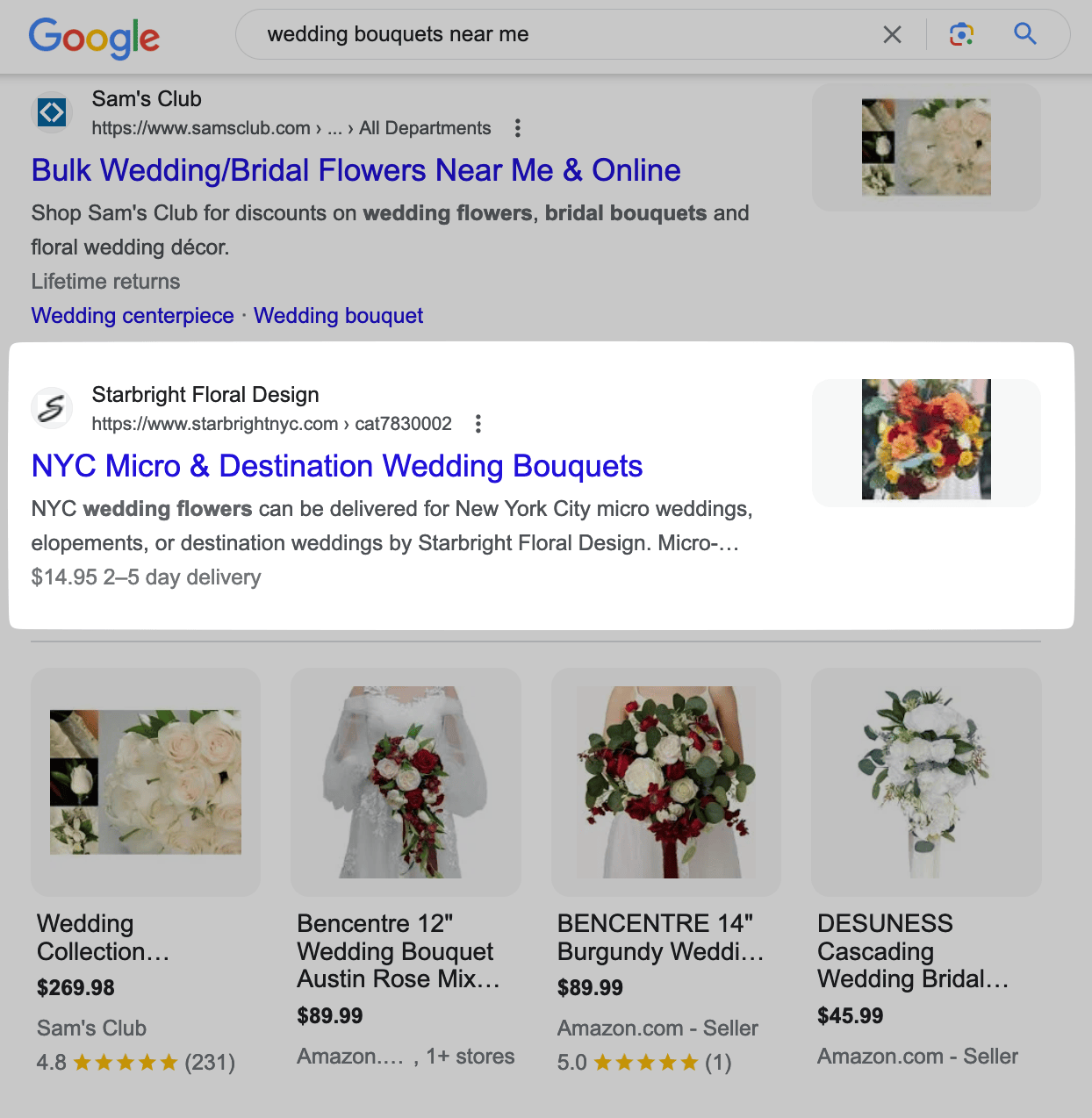
That means target customers in the area are more likely to find the business when looking for wedding flowers.
How do we know?
Fintech company Klarna found that 83% of shoppers research products online before visiting a store. By capturing some of this traffic through its local SEO efforts, Starbright Floral Design can create new sales opportunities.
Which Businesses Benefit from Local Marketing?
Local marketing can be helpful for all businesses with audiences in specific locations. But it’s critical for those serving customers face-to-face. Such as:
- Restaurants, cafes, and bars that rely heavily on local foot traffic and bookings. Many benefit from promotions aimed at nearby residents.
- Retailers and boutiques that want to attract people to physical locations for browsing and collecting items
- Professional service providers like lawyers, doctors, and consultants that depend on building awareness and trust in their local communities
- Home service providers like plumbers, electricians, and other contractors that often serve specific geographic areas so they can visit customers’ properties
- Event planners that offer location-specific services. Where local business marketing is vital even if the company works remotely.
- Car dealerships that depend on people in the surrounding area for purchases
These businesses employ various techniques to attract their desired customers.
For instance, Electric car maker Polestar uses targeted social media ads to reach Instagram users near its showrooms.
The “Learn more” button below takes interested users to a landing page about the company’s physical location.
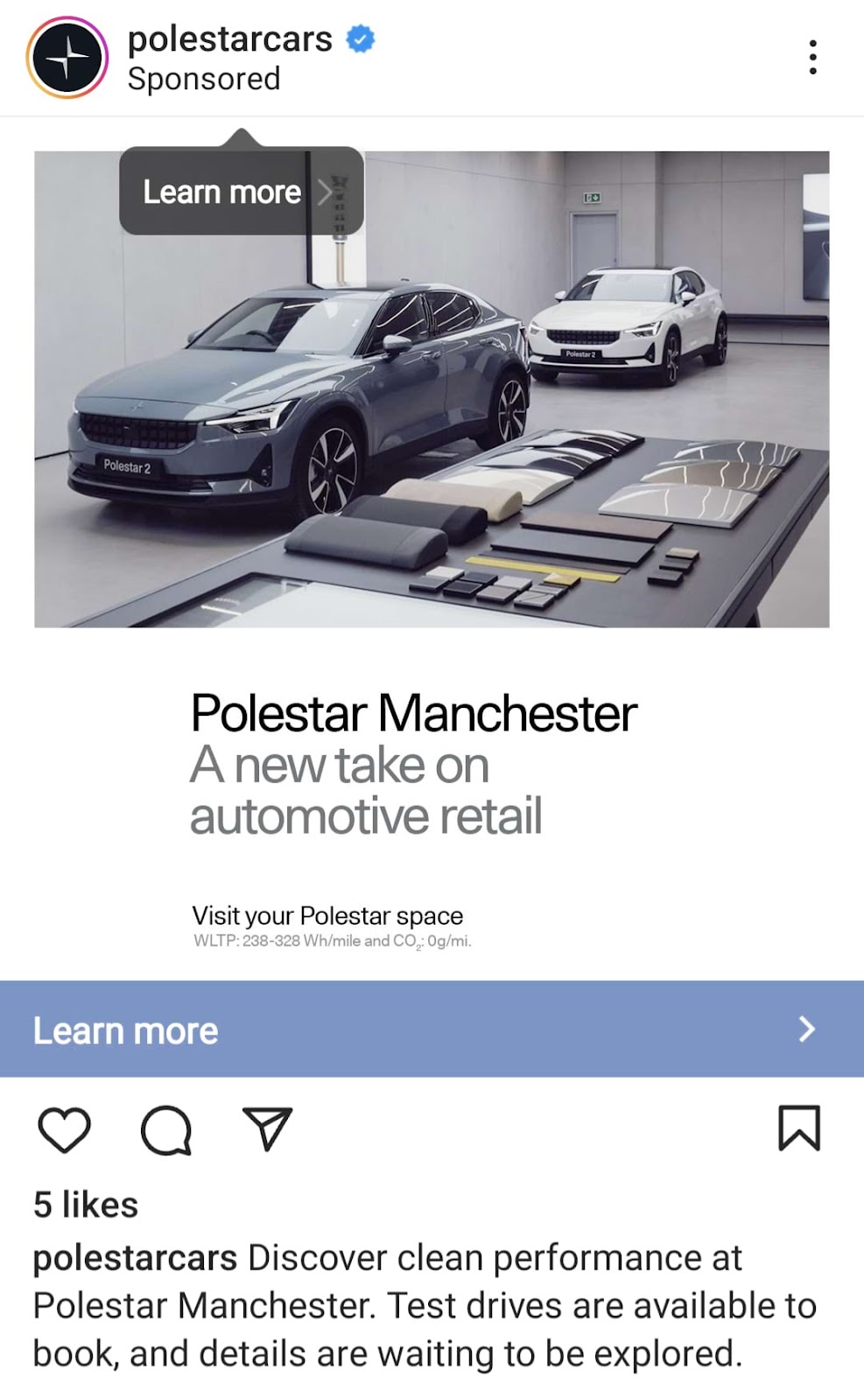
Precise targeting ensures Polestar’s online message only reaches people who can visit the Manchester, UK site. So none of its reach or investment goes to waste.
Note how the landing page promises a smooth and relaxed in-store customer experience. Polestar extends the self-paced, online shopping experience to its offline location. Making social media users more likely to visit.
Even nationwide and global brands can harness local marketing to drive business.
McDonald’s uses billboards and other physical ad platforms to drive awareness and interest.
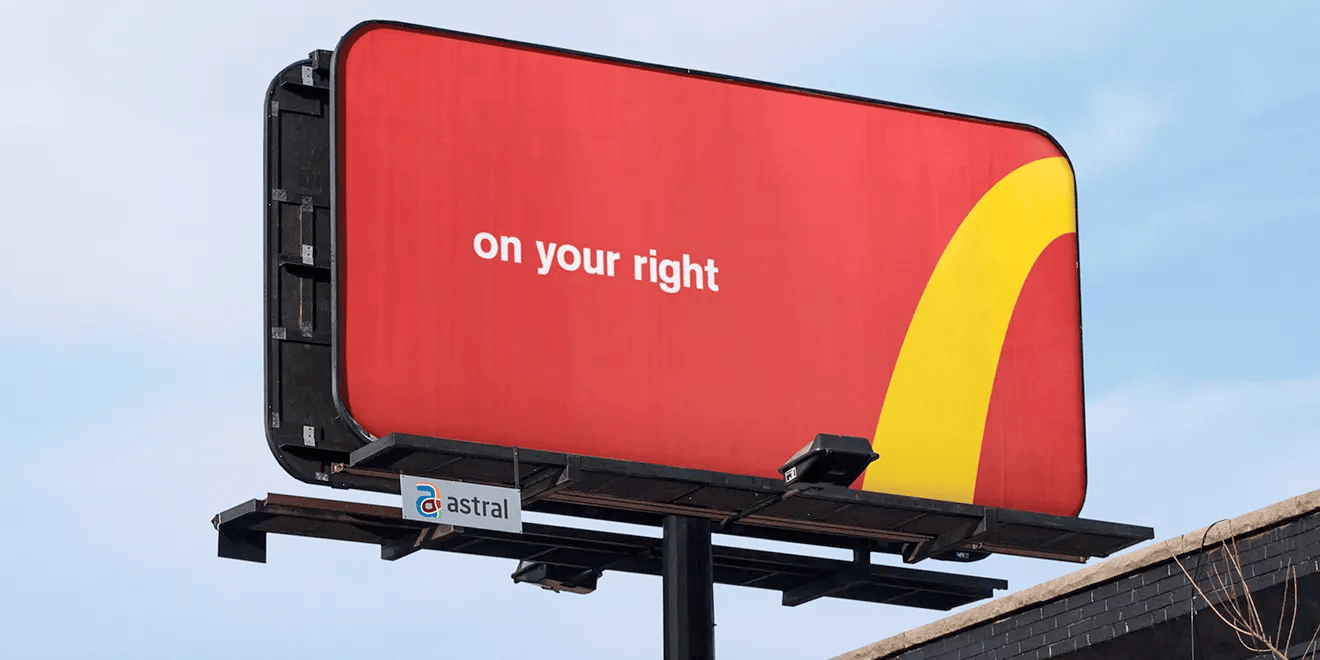
Image Source: AdWeek
The signs aim to divert road and foot traffic toward its nearby restaurants.
The above are only two examples of effective local business marketing techniques. There’s plenty more you can do to engage and convert your local audiences.
11 Local Marketing Strategies You Can Use Right Now
Here are 11 proven ways your business can attract and engage local customers.
1. Optimize Your Website for Local Users
Start by tailoring your online presence to resonate with the specific needs and interests of your local target audience.
This practice is known as local SEO. It helps you increase your website’s ranking in local search results, making it easier for potential customers in your area to find you.
For instance, if you run a bakery in Seattle, optimize your website with keywords like “Seattle bakery” to potentially boost your local online search presence. Content that highlights the local food culture in Seattle may also help.
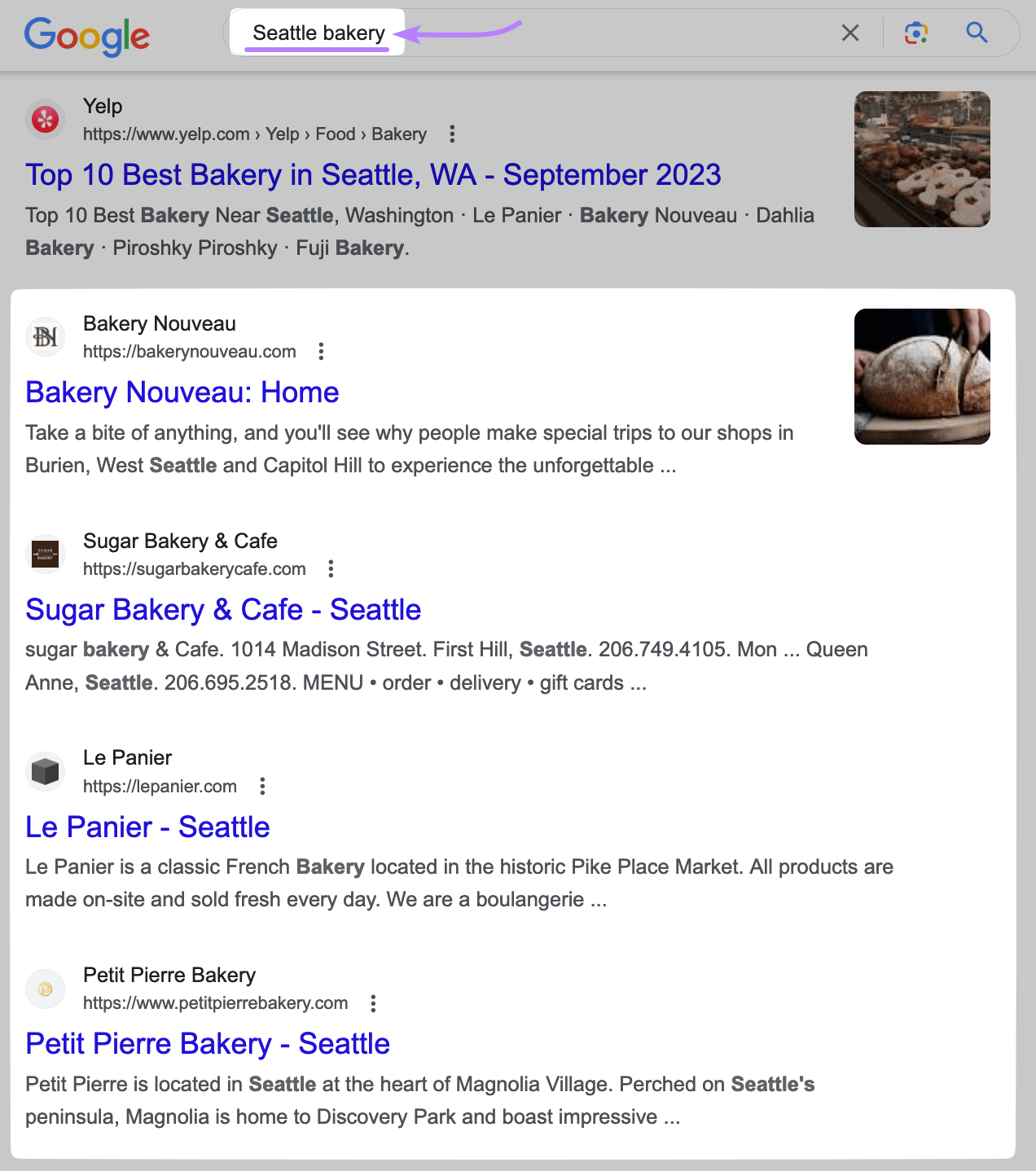
To make your business more visible in the SERPs:
- Integrate local keywords naturally into your content
- Develop a dedicated “locations” page. Containing detailed information about your physical address and contact details.
- Ensure NAP (name, address, phone number) information on your website is consistent and accurate
Semrush’s Keyword Magic Tool helps you find terms worth targeting in your content.
Start by typing a seed keyword into the search box. A short term that describes your business is ideal.
Then choose a region and click “Search.”

The tool will present a list of keywords that contain the seed keyword or a variation. You can narrow these down to terms with local intent by applying filters. The most useful here is “Include keywords.”
Add the cities, towns, and districts your customers might use in their searches.
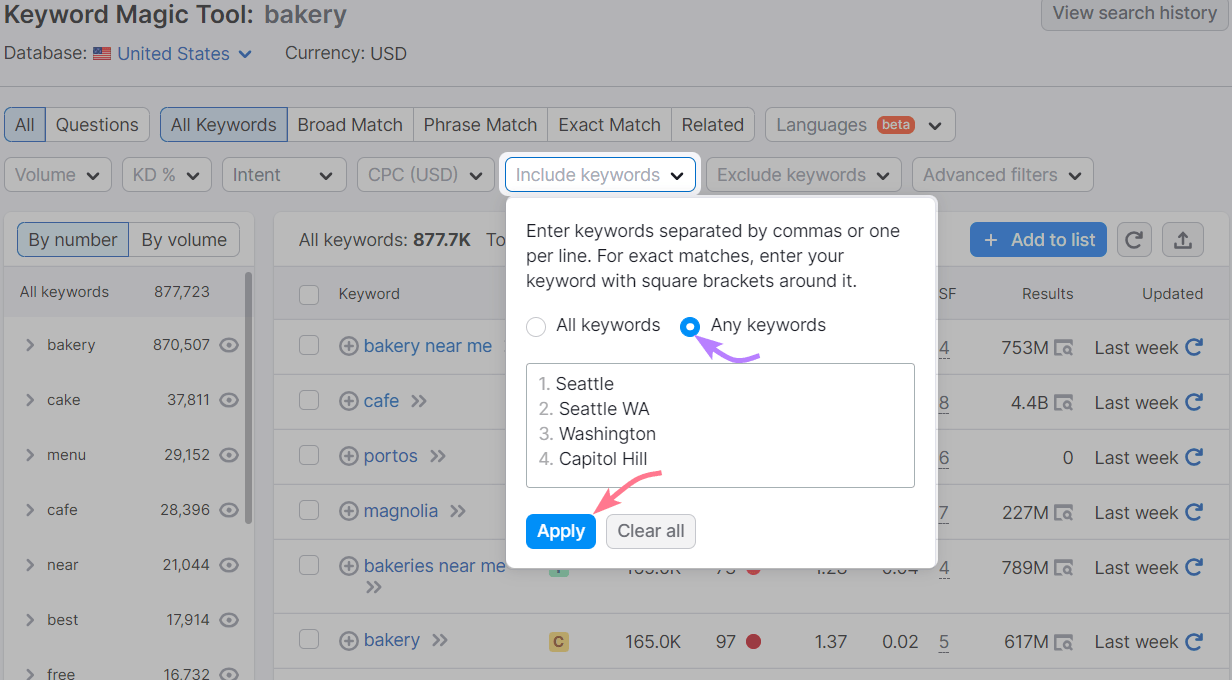
Check off “Any keywords,” then click “Apply.”
You’ll see local keywords to consider for your website content.
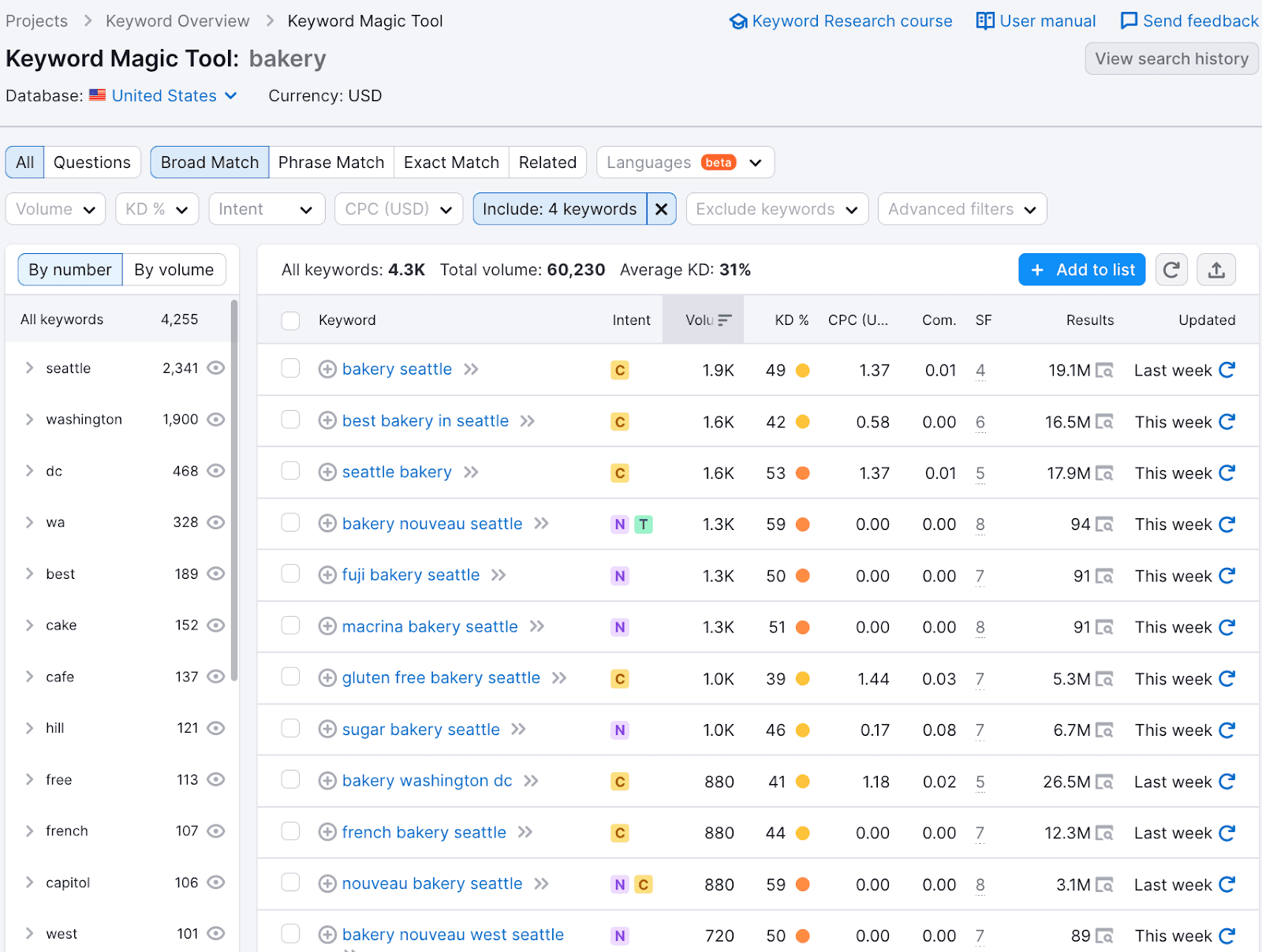
Order the list by search volume (“Volume”) and look for terms near the top with the lowest keyword difficulty (“KD %”) scores. These will be the easiest to rank for.
Further reading: Local Keyword Research for SEO: What It Is & How to Do It
2. Create Local Landing Pages for Your Business Locations
A landing page persuades users to take a specific action. For example, signing up for a newsletter or purchasing a product.
Users can find your landing page through pay-per-click (PPC) advertising campaigns, social media posts, organic search results, or emails.
Regardless of the source, the goal is to drive conversions.
If you have multiple locations, set up individual dedicated landing pages. You’ll streamline the user experience and improve local search visibility.
Use your landing page content to help potential customers plan their visits.
For example, anyone searching “Mowgli Liverpool” on Google (perhaps after hearing about it through word of mouth) will find information on the UK restaurant chain’s Liverpool branch.
The location-specific landing page shows the address, business hours, background story, and contact details.
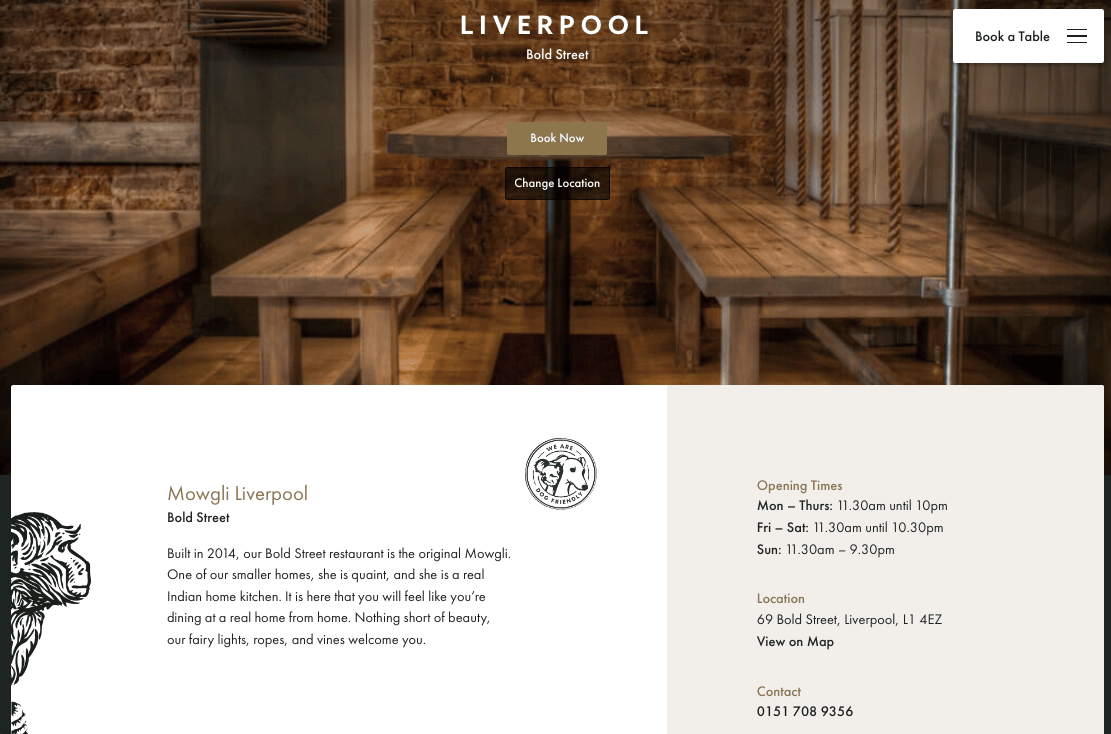
That means a website user considering a visit has all the details they need beforehand.
To improve your online visibility, weave terms into your landing page content that local customers may search for.
Like Mowgli does with:
- “Mowgli Liverpool”
- “Bold Street restaurant”
- “Real Indian home kitchen”
You’re more likely to rank in the SERPs for these queries if you do. Making it easier for new customers to find you.
You can also monitor keyword performance and your content optimization efforts using Semrush’s Position Tracking tool.
To get started, enter your domain and click “Set up tracking.”

A few tips as you populate the campaign:
- If you have multiple locations, set up tracking for each location URL
- Set the “Device” to “Mobile” to track mobile rankings
- Set the “Location” to track rankings by searcher (i.e., your target audience’s) location
Click “Continue To Keywords.”
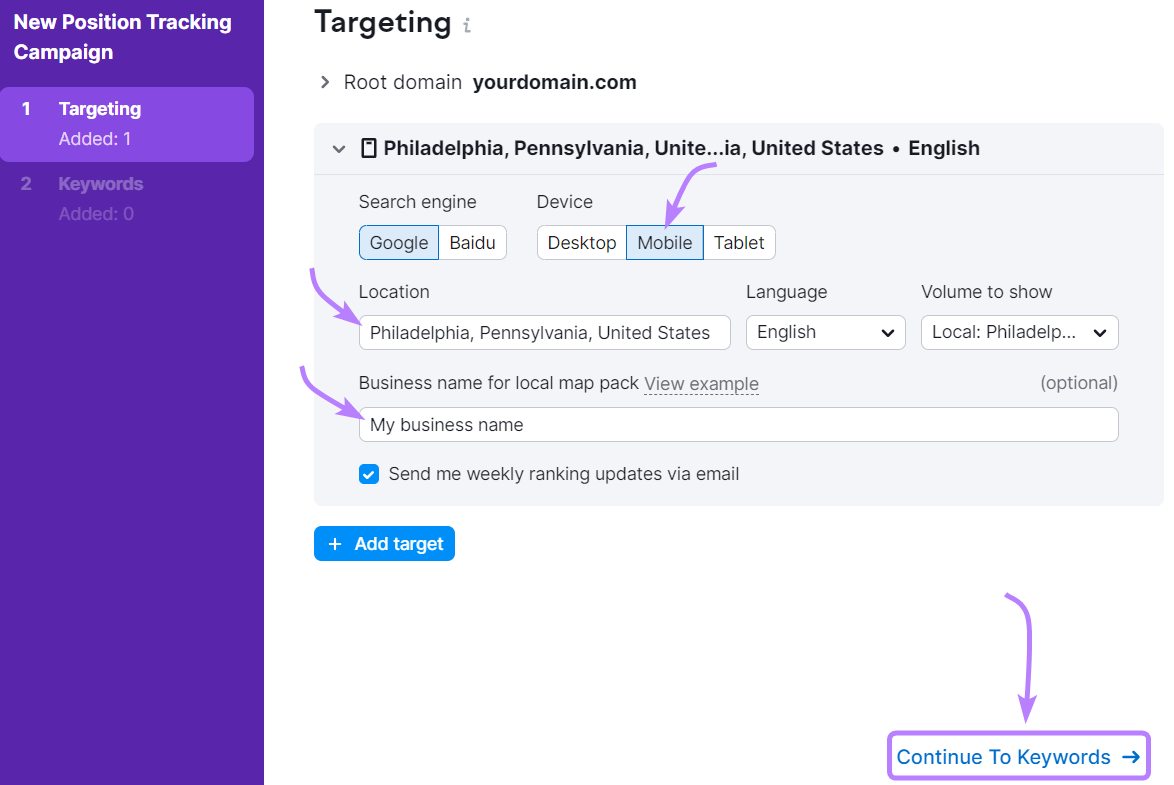
Export your local keywords from the Keyword Manager or your spreadsheet as a CSV file. Then use the “Import from” button to add them here.
Once you’re ready, click “Add keywords to campaign” followed by “Start Tracking.”
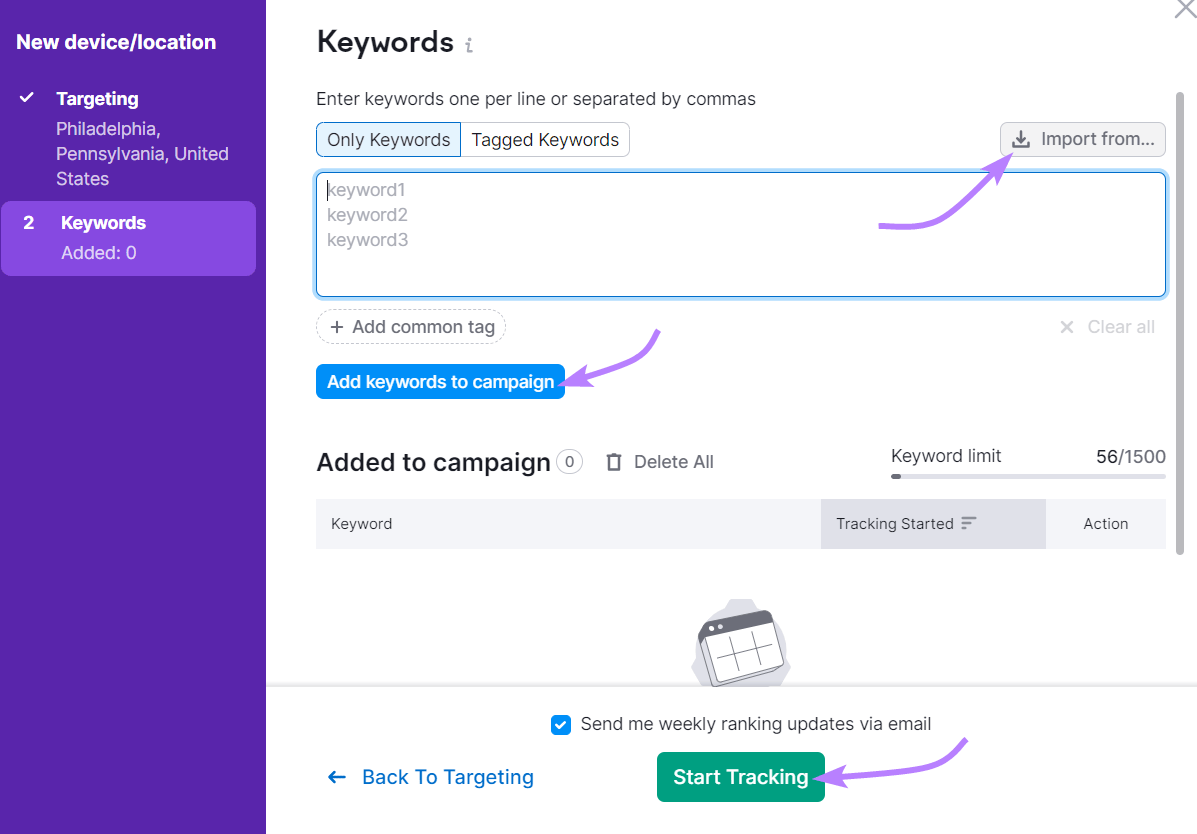
After a few minutes, the tool will generate the data. For example, the “Rankings Overview” tab displays your current and previous ranking for each keyword.
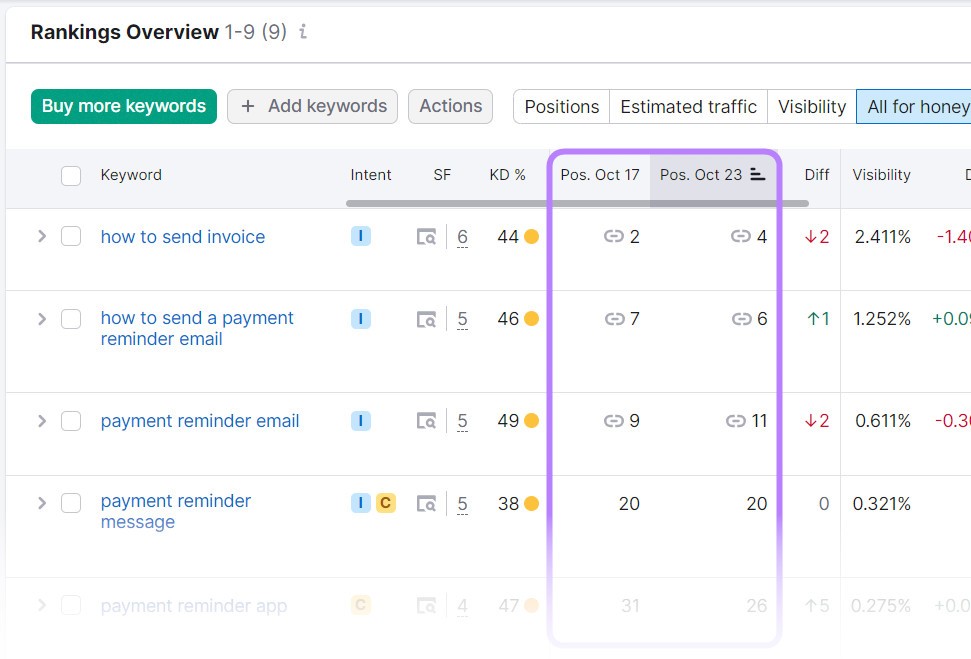
Use the information from the Position Tracking tool to determine which keywords to include on your landing pages.
3. Claim or Create a Google Business Profile
A Google Business Profile (GBP) account lets you manage how your business appears on Google Search, Google Maps, and Google Shopping.
It ensures local users find accurate and helpful information when searching for your business, products, or services.
For instance, a local gift store that claims its GBP can publicize its store hours, location, and contact details.
Like retail store Nothing Too Fancy does here:
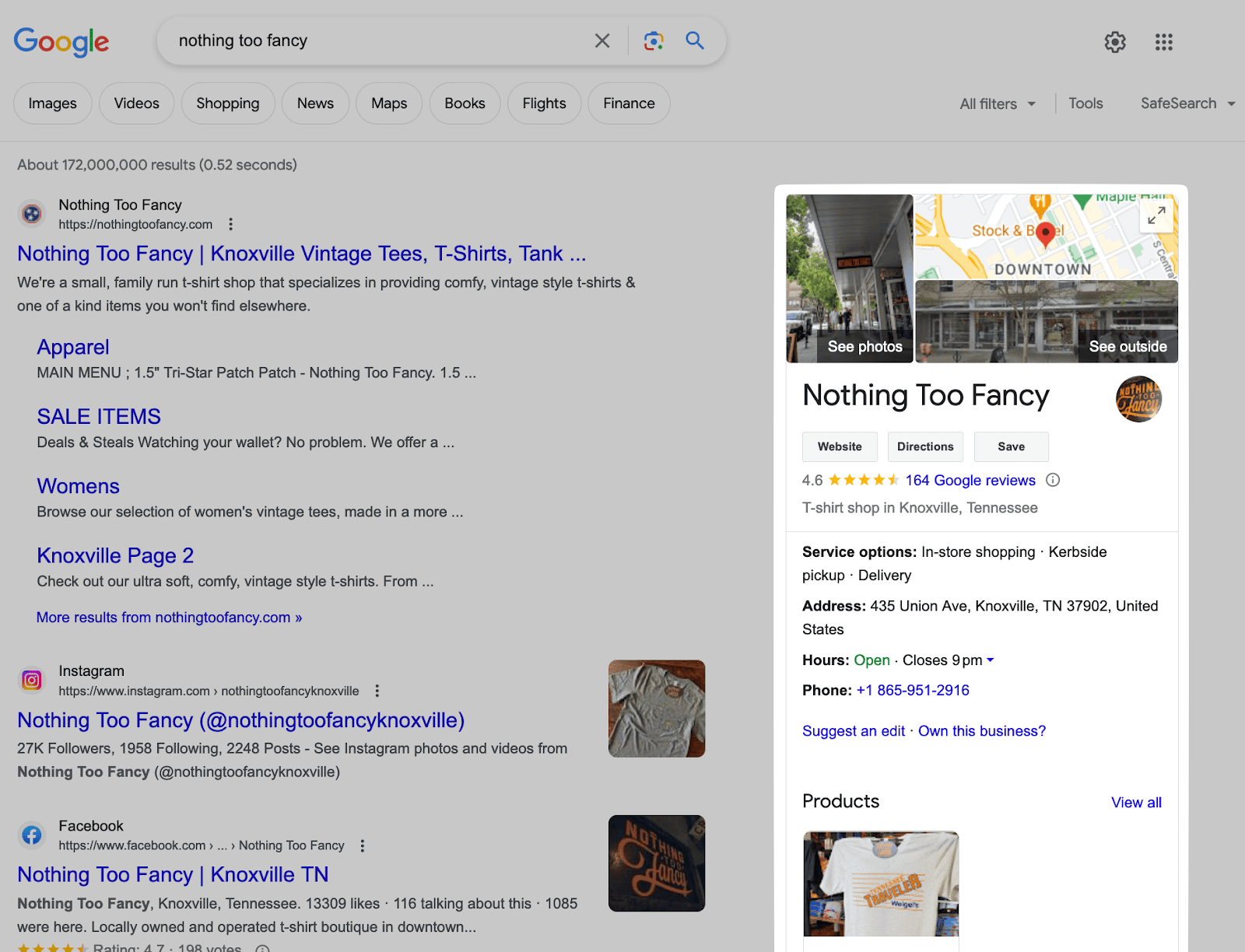
You can also upload high-quality images of your storefront and products. Giving potential customers a preview of what’s available.
To get the most out of your GBP:
- Verify the accuracy of your profile details
- Update your profile regularly with high-quality images
- Encourage satisfied customers to leave positive feedback
- Respond promptly and professionally to customer reviews
These actions will help you build trust and credibility with your local audience. And give search engine users a convenient introduction to your business.
To set up GBP from scratch, go to Google Maps. Search for your business and then click “Claim this business.”
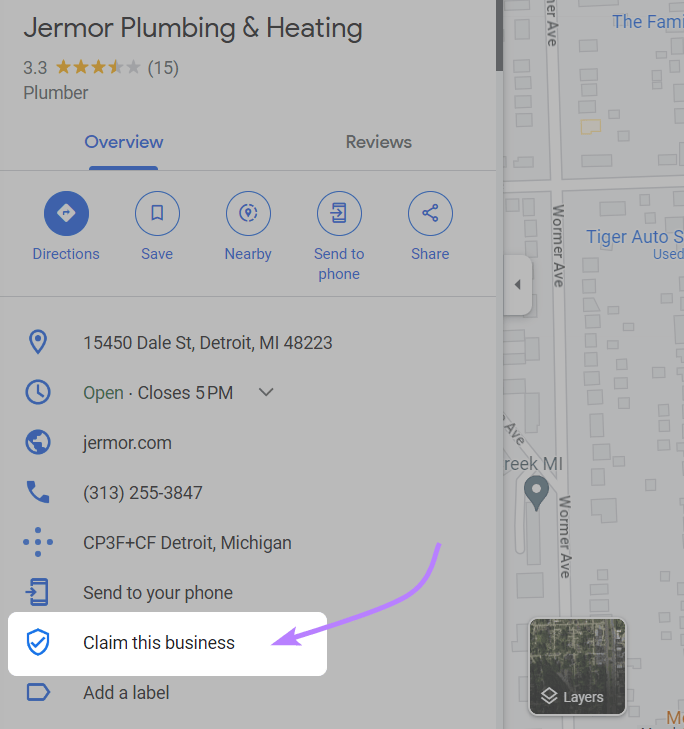
Then click “Manage now.”
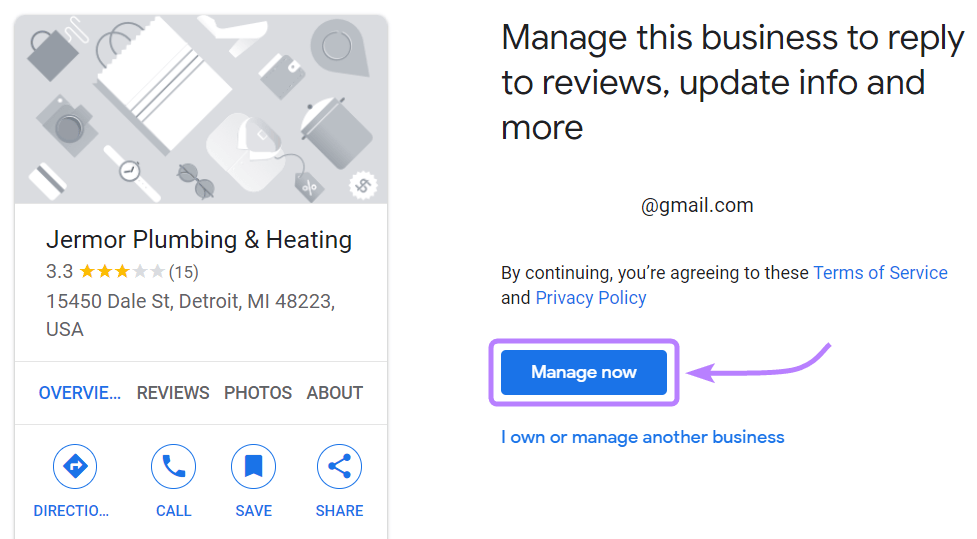
Once you’ve verified your identity, open the hamburger menu button to the left of the search bar.

Select “Add your business.”
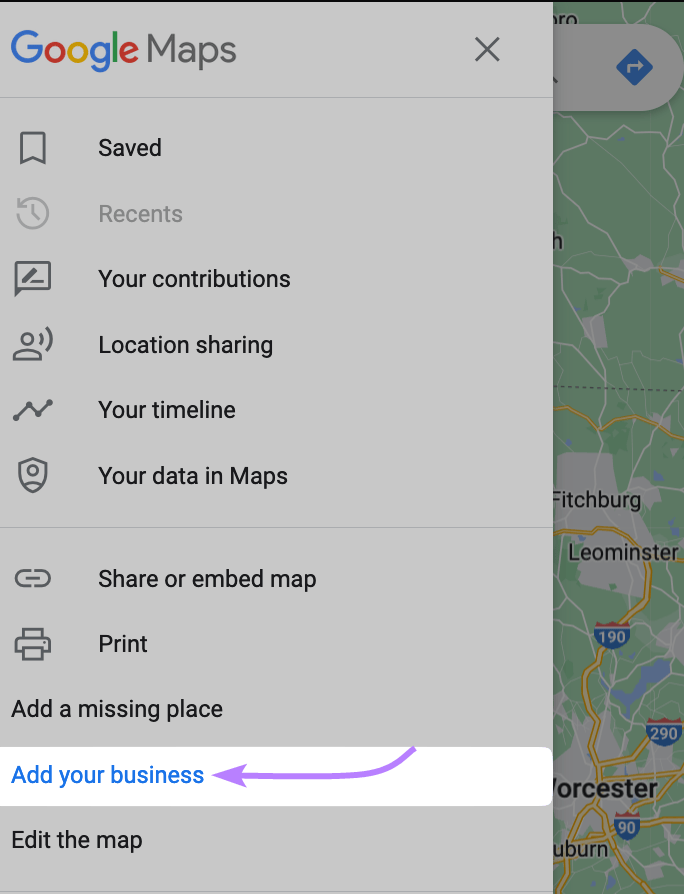
Google will now ask for some basic details and walk you through the process.
The site auto-generates and updates listings without needing business owners’ involvement.
To claim an existing listing, search for your company name on Google Maps.
Then, click “Claim this business.”
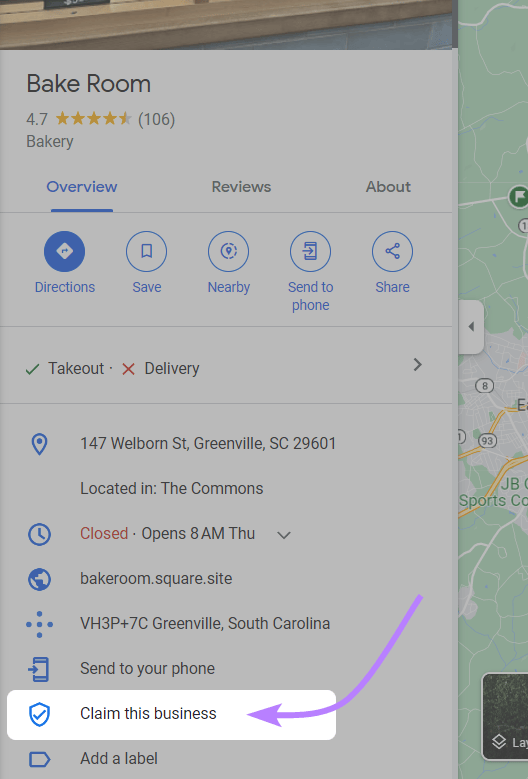
Again, Google will ask for your business details and walk you through the steps.
Once you’ve completed this process, integrate Semrush’s Listing Management tool with your GBP. It will give you the necessary insights to get your products in front of prospective local customers.
We’ll cover Listing Management in more detail in the section below.
Further reading: We explore these setup processes in more detail in our Guide to Google Business Profile.
4. Optimize Your Google Business Profile Listing
Provide as much relevant information as possible to potential customers. You’ll help them decide whether to visit or buy from your company.
Your optimized GBP will significantly increase your chances of appearing in SERP features—unique results that appear alongside your search listing and provide additional information. Think of elements like images and reviews.
One such SERP feature is the local pack, which shows location-specific results related to a query.
Local packs tend to appear in searches with commercial intent. Which is when people are looking for a product or service.
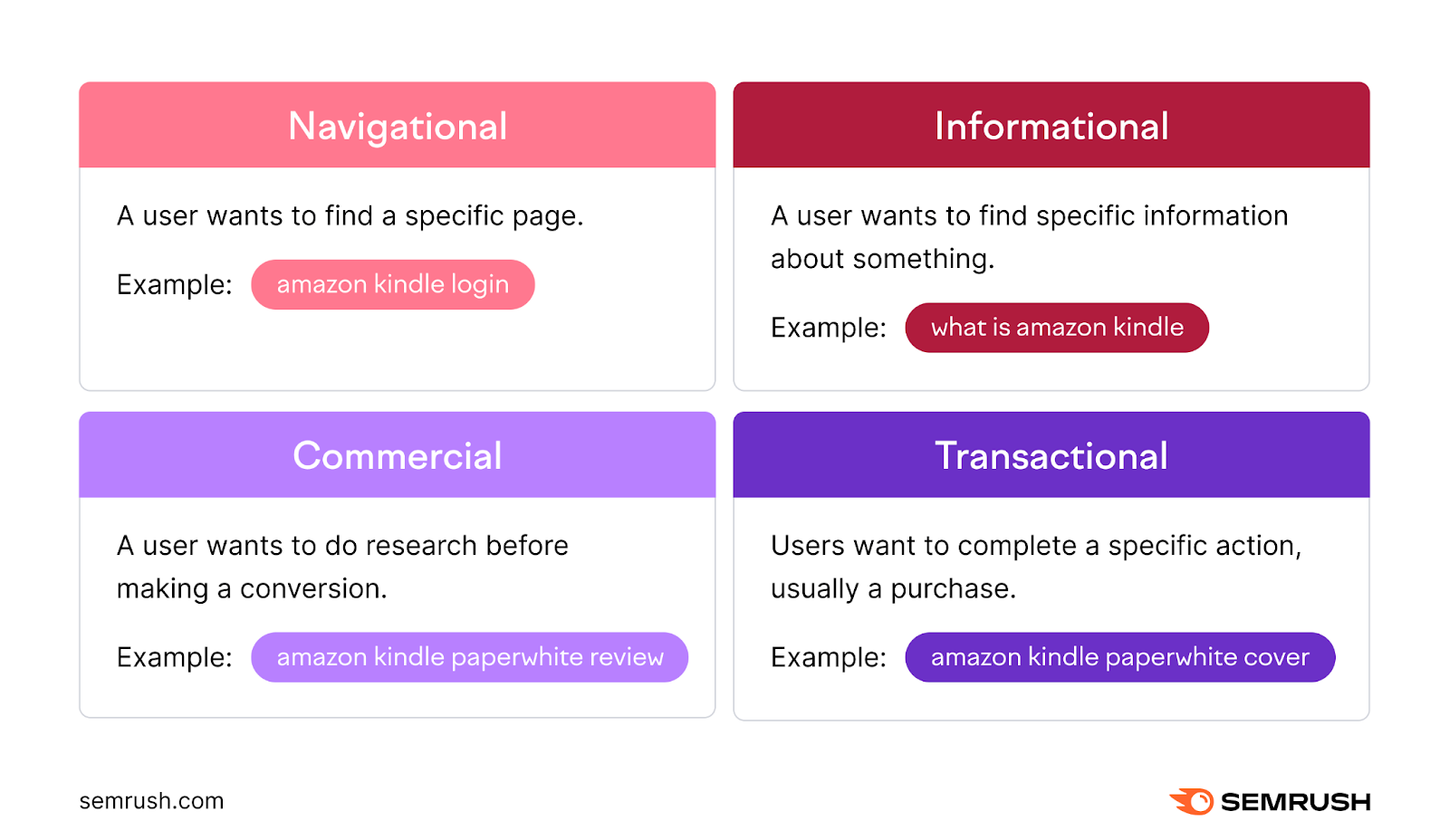
One example is “birthday cakes in Melbourne”:
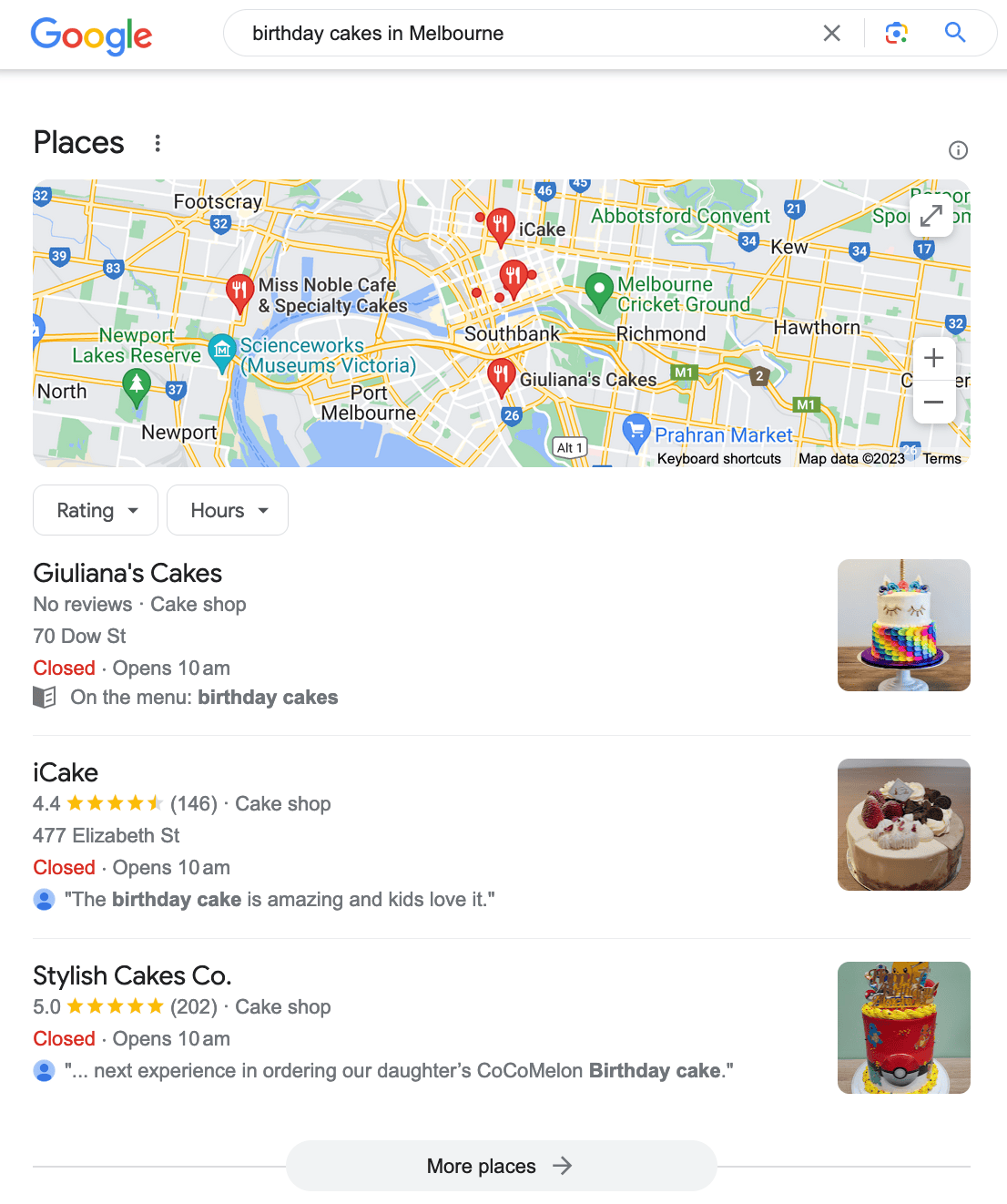
Say you run a restaurant. Your GBP optimization might involve adding a comprehensive menu. Or updating business hours to reflect special events and holidays. Even responding promptly to both positive and negative customer reviews.
To get your Google Business Profile into search- and user-friendly shape:
- Fill out all available sections with detailed and accurate information
- Select the most appropriate categories for your business
- Ensure your contact information and hours of operation are consistent across your online platforms
You can also add keywords to your Google Business Profile. To make your business more visible in the SERPs and potentially drive local search traffic to your website.
For maximum visibility and user convenience, use relevant keywords (e.g., terms you discover in the Keyword Magic Tool) across these areas of your business profile:
- Business Categories
- Business Description
- Product Descriptions
- Service Descriptions
- Business Attributes
Explore GBP content optimization in full detail in our How to Add Keywords to a Google My Business Profile guide.
Semrush’s Listing Management tool makes it easy to keep your business information consistent across online directories, social media platforms, navigation services, and other channels.
Enter your business name and NAP information in the tool. Semrush will submit this data to 70+ directories in the US and more than 40 in other countries. Including Google, Bing, Apple, and Amazon Alexa.
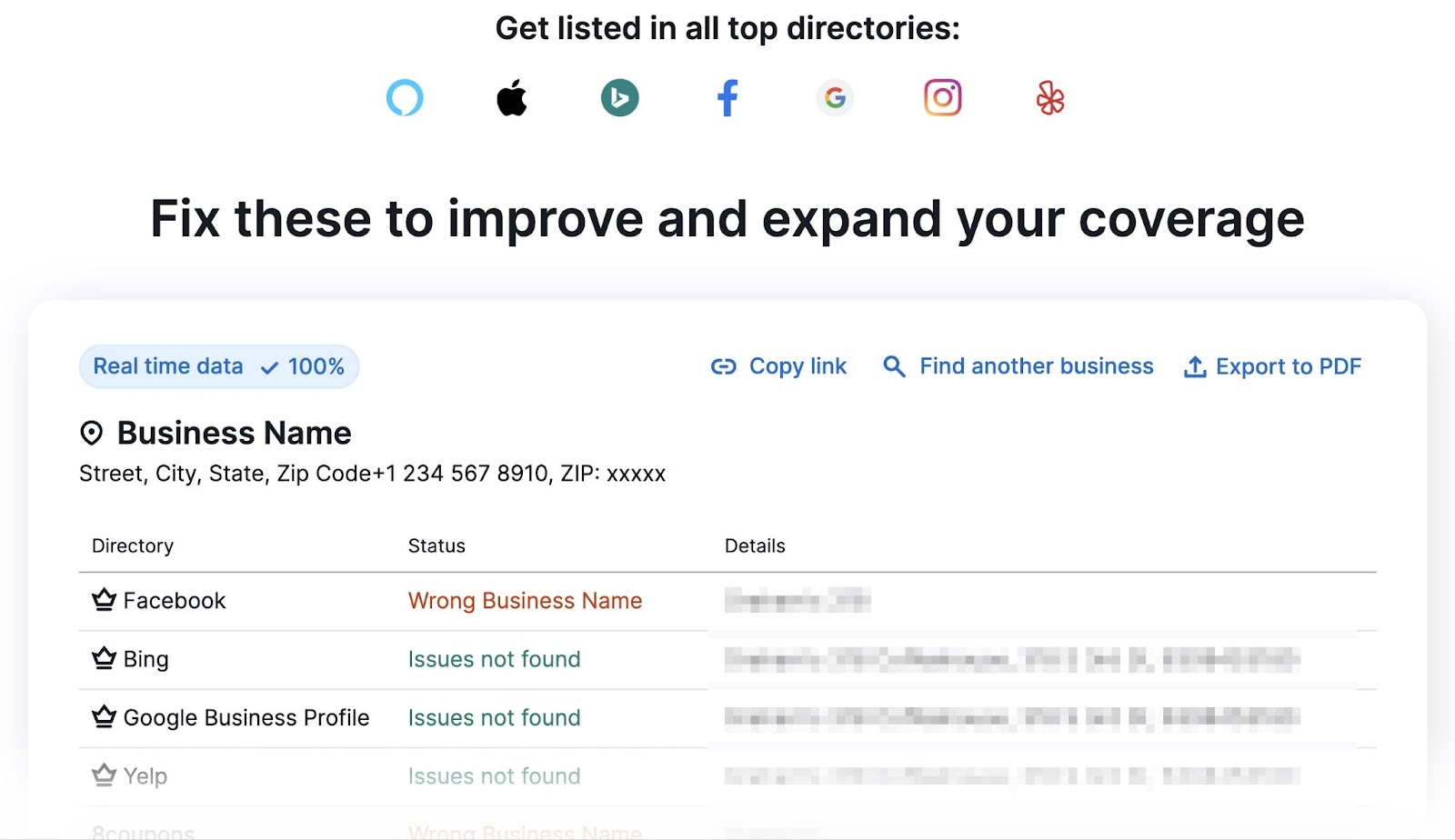
Listing Management will notify you of any issues so you can correct them.
You also get access to the GBP Insights report. Which pulls metrics that reflect your listing’s performance in local search.
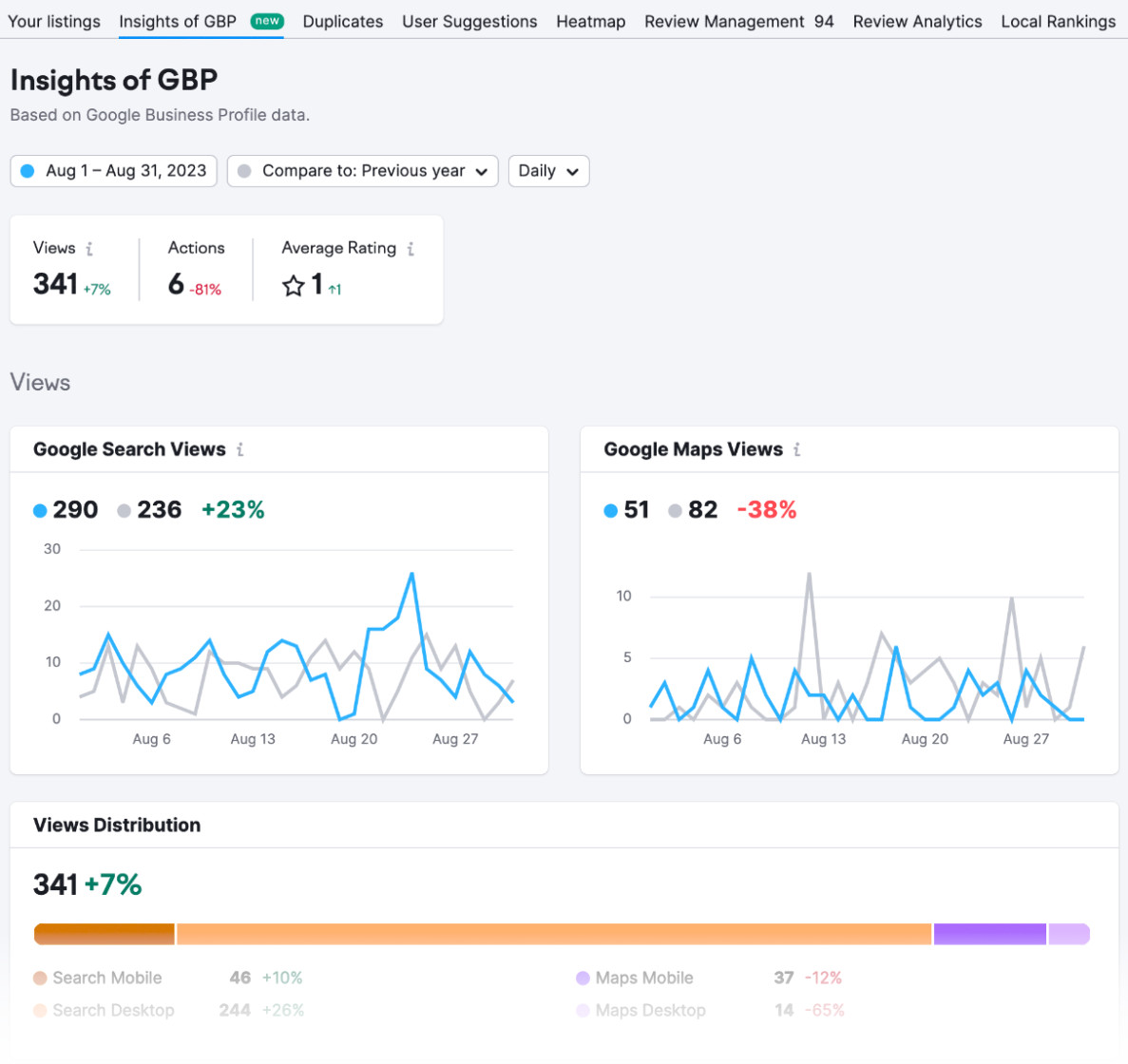
Use this information and the tool’s performance reporting functionality to guide your local marketing strategy. And make changes where needed to increase your visibility.
5. Maintain Your Google Maps Data
Ensure your business’s Google Maps data is accurate so locals can easily find you. Then you won’t miss out on opportunities to engage new customers.
If someone can’t locate you properly because of inaccurate Maps data, you’ll not only lose their business. They may tell others about their frustrating experience—which may harm your reputation.
CRM platform Salesforce found that according to 88% of consumers, the experience a company provides is as important as its products or services. Being easy to find is a simple but essential part of that.
So check and update your business location on Google Maps. Open your Google Business Profile and click “Edit profile.”

Find the “Location” tab. Check your “Business location” data and edit if necessary.
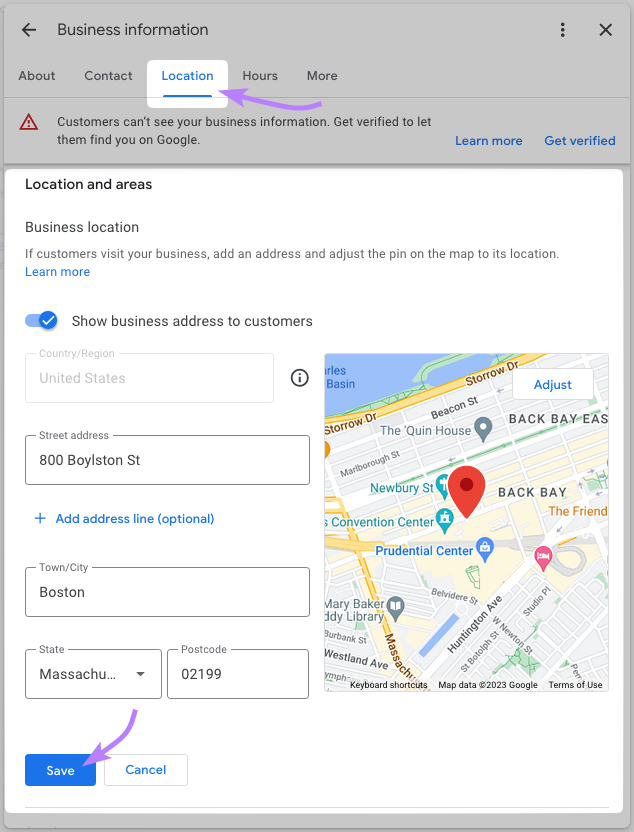
If the entered address doesn’t show your exact location on the map, adjust the pinpoint manually.
Press “Save” when the location is correct. Then set a monthly reminder to check this and other details on your profile.
Tailor your social media profiles to local users. You’ll help people in the area to find your business and build relationships with you.
Begin by making your location information visible to anyone who lands on your profiles for the first time.
If you operate in a single location, include it in your bio.
Like this:
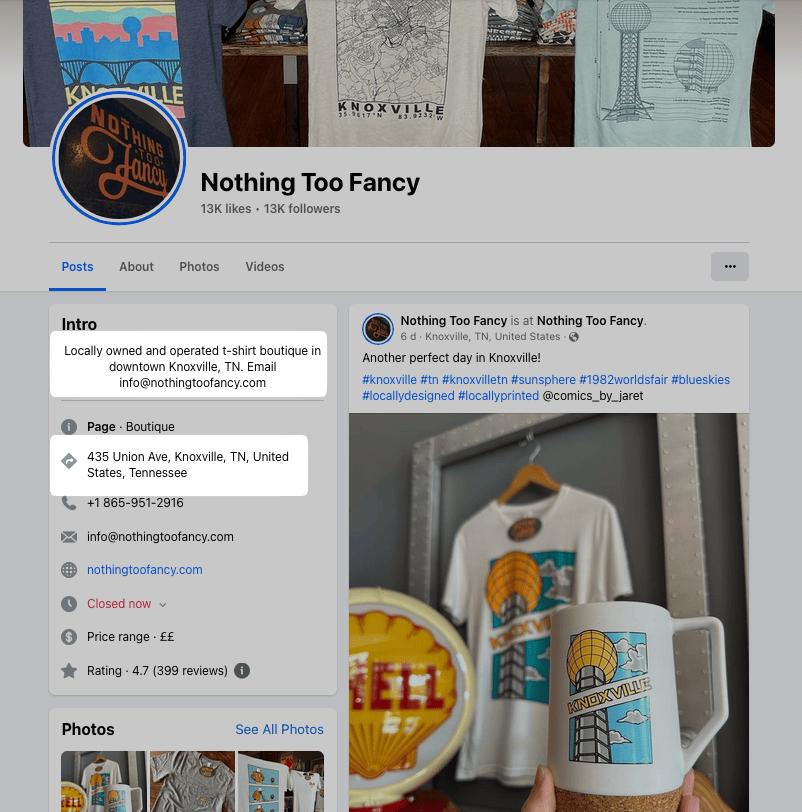
For multiple locations, you might want to use a bio-linking tool (like Linktree), pinned posts, or Instagram Stories.
Hale Coffee (@halecoffee) has a bio link and a highlighted Story on Instagram called “Locations.”

When visitors click on it, they see information on all four Hale Coffee branches. Here’s what one looks like:
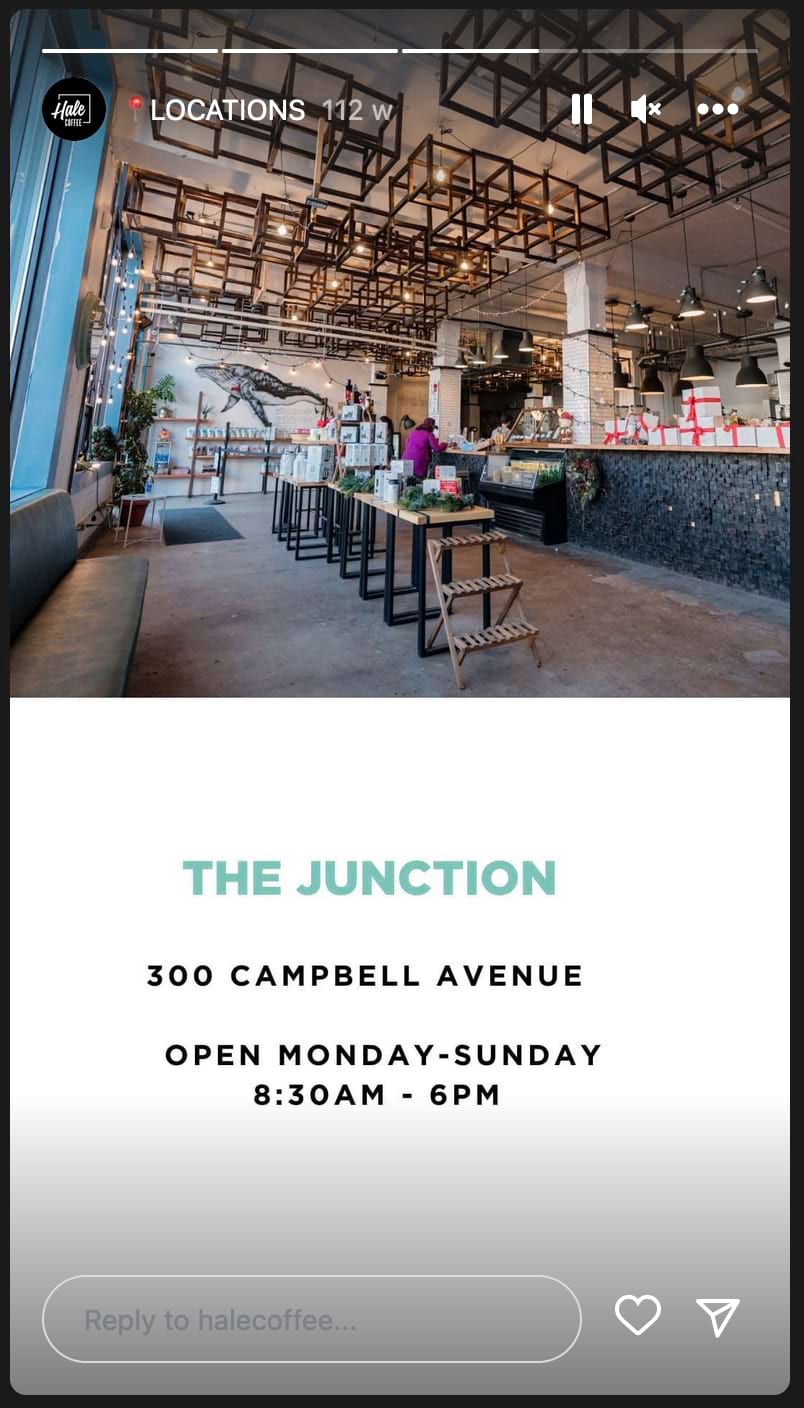
Another way to attract users nearby: Add location tags and area-relevant hashtags to individual posts.
Again, Hale Coffee does this well.
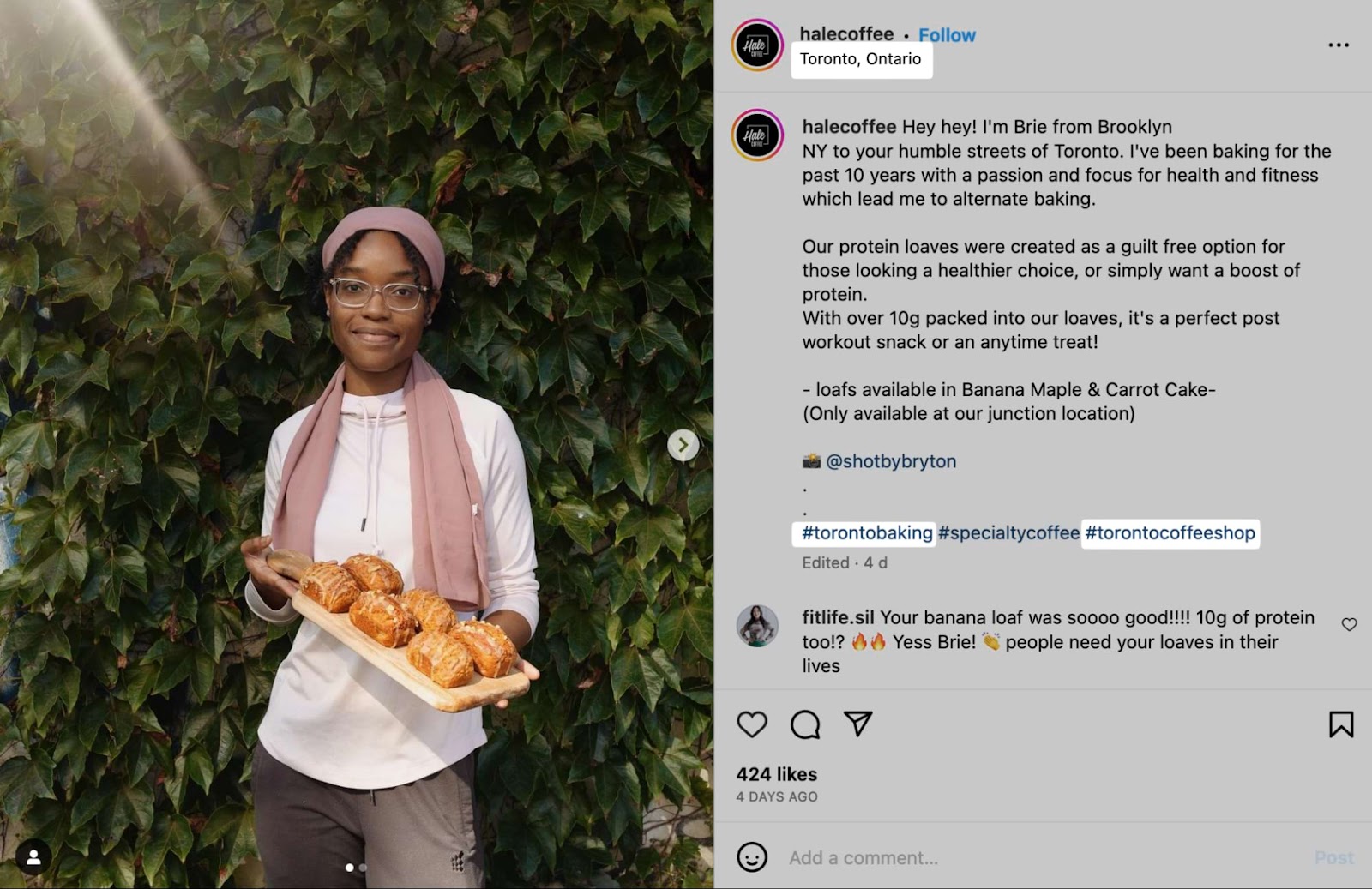
Anyone who searches for or follows those terms on Instagram (i.e., mostly people who live in or visit Toronto) can see and potentially engage with Hale Coffee’s post.
7. Create Locally Relevant Social Media Marketing Content
Create social media content that speaks to your local audience’s interests. It’s a way to foster engagement and strengthen brand loyalty.
How do you achieve that exactly?
By proving you’re an important member of the community.
For example, clothing company Rapanui works with its coastal community to tackle local environmental issues.
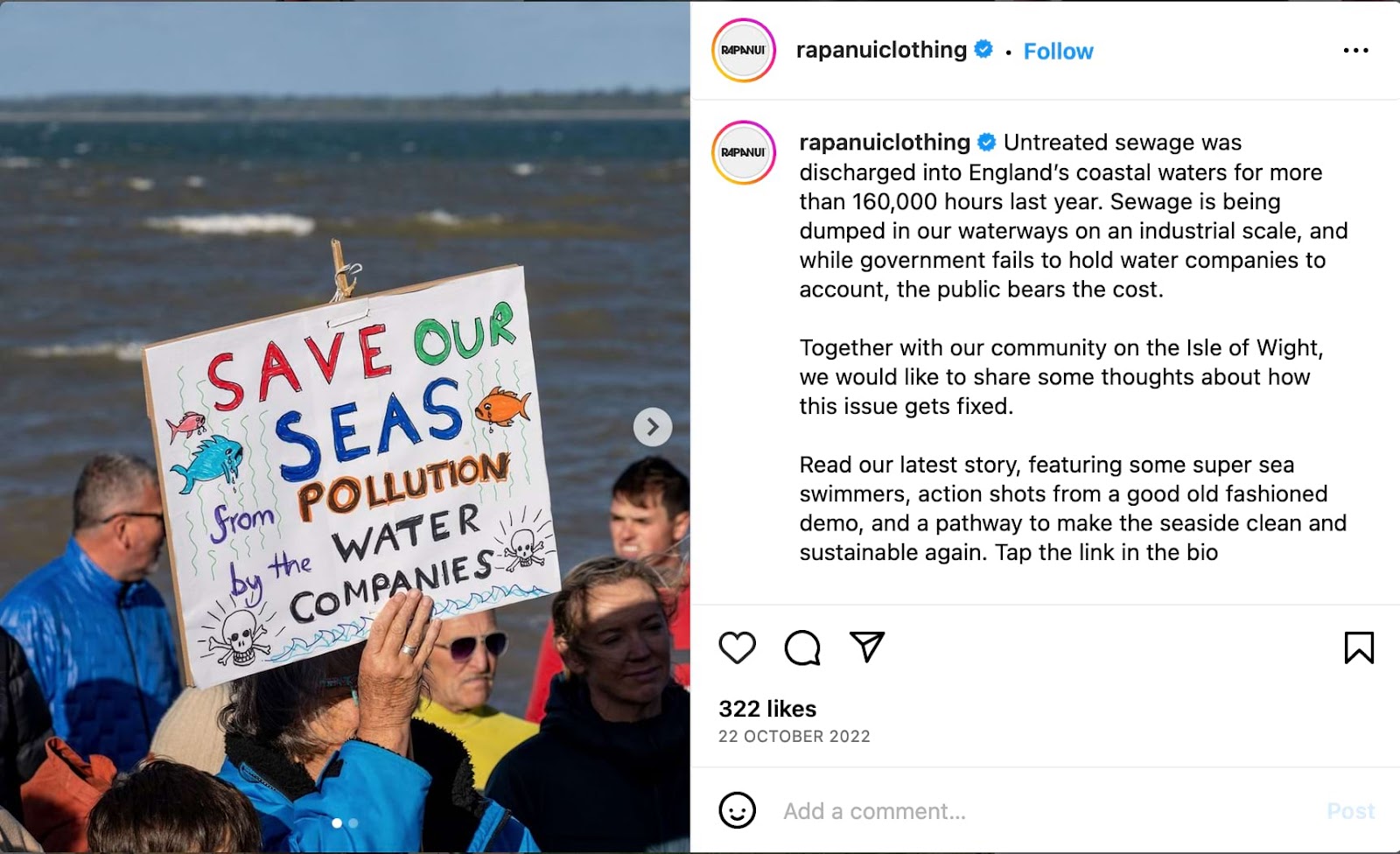
By posting about the topic, the company encourages engagement and highlights its value to the area.
Consider what your customer base cares most about when planning your social media content. Make sure your posts are relevant to them. Include calls to action (CTAs) or ask direct questions to invite people to share their opinions.
To understand what your customers care about:
- Draw on past conversations
- Monitor buying habits over time
- Check your social media posts and website content to see what gets the most engagement
You can find your top-performing website content on Google Analytics.
Head to your “Reports snapshot.” Under “Engagement,” select “Pages and screens.”
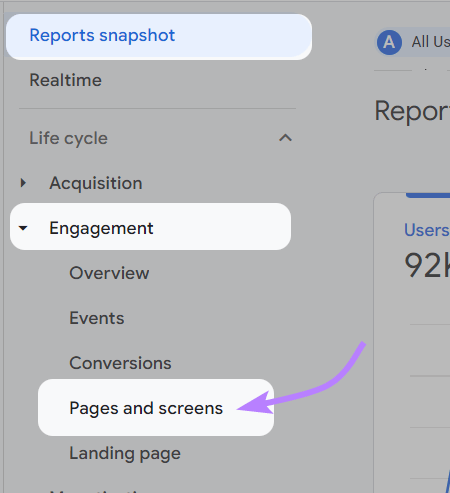
You’ll see metrics for all pages on your site:
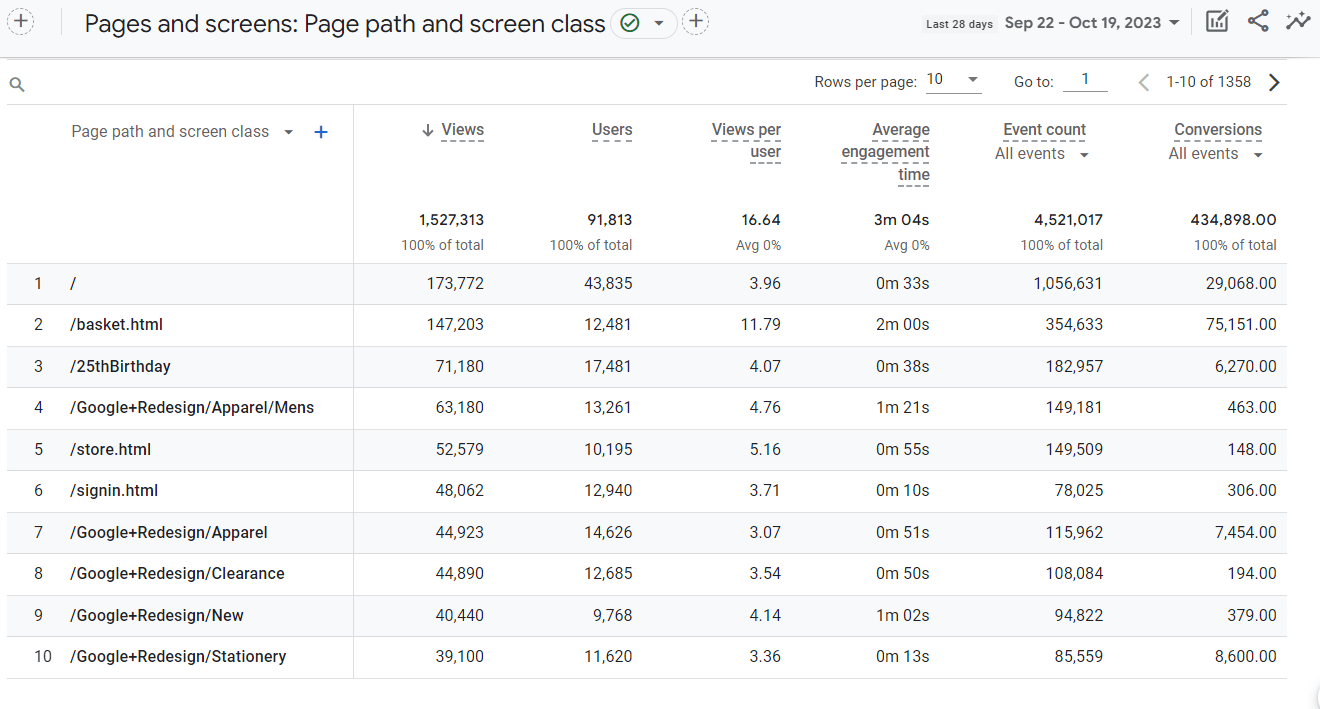
Use the arrow next to the column header to sort the list by “Views,” “Views per user,” or “Average engagement time.”

You’ll likely see high-traffic pages like your homepage and some high-level content (e.g., product category pages) at the top. But watch for blog posts and specific product pages to better understand which topics resonate most with your audience.
You can search for specific topics and content types (such as blogs) in the top left text box.

Look for common themes across your top-performing pages. Then build these into your social media content plan.
8. Encourage and Engage with Online Reviews
Reviews are powerful marketing tools for small business owners with fewer resources.
Software company Podium found that reviews influence 88% of consumers in their discovery of local companies. 85% of shoppers had read at least one review in the last month at the time of the report.
You can’t control what people write about your business online. But you can increase your potential for positive reviews by:
- Delivering thoughtful, personalized customer experiences
- Encouraging people to leave reviews on search, social, and dedicated feedback channels (e.g., Google Reviews and Yelp)
- Addressing shoppers’ concerns before they escalate
Negative reviews are inevitable in most industries. But you can mitigate their impact when you address them promptly and professionally.
The best way to deal with a negative review? Always prioritize solving your customer’s problem over debating the details or getting defensive.
Here’s how the team at Amsterdam’s art’otel responds to negative reviews on Tripadvisor:
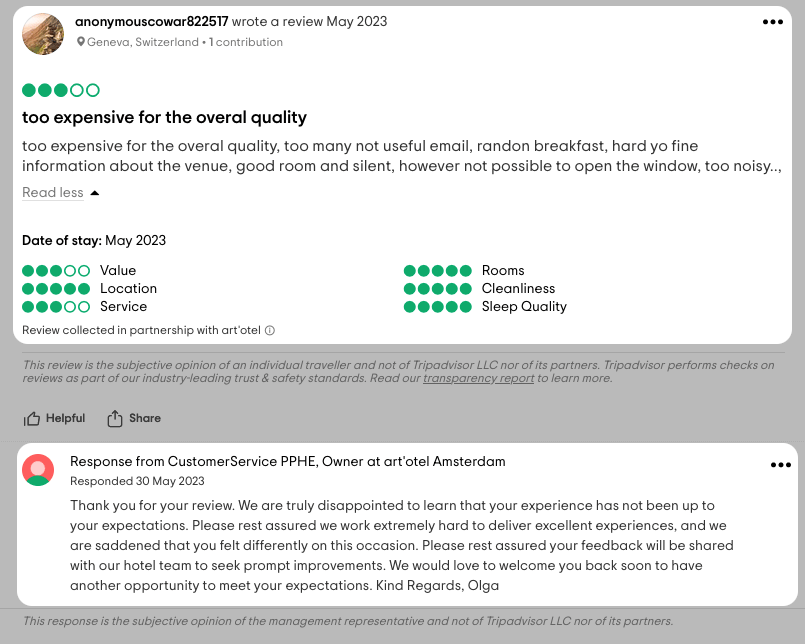
Other users can see that the company takes customer feedback seriously and is willing to improve.
Listing Management makes it easy to track and respond to Google and Facebook reviews. Simply click on the “Review Management” tab.
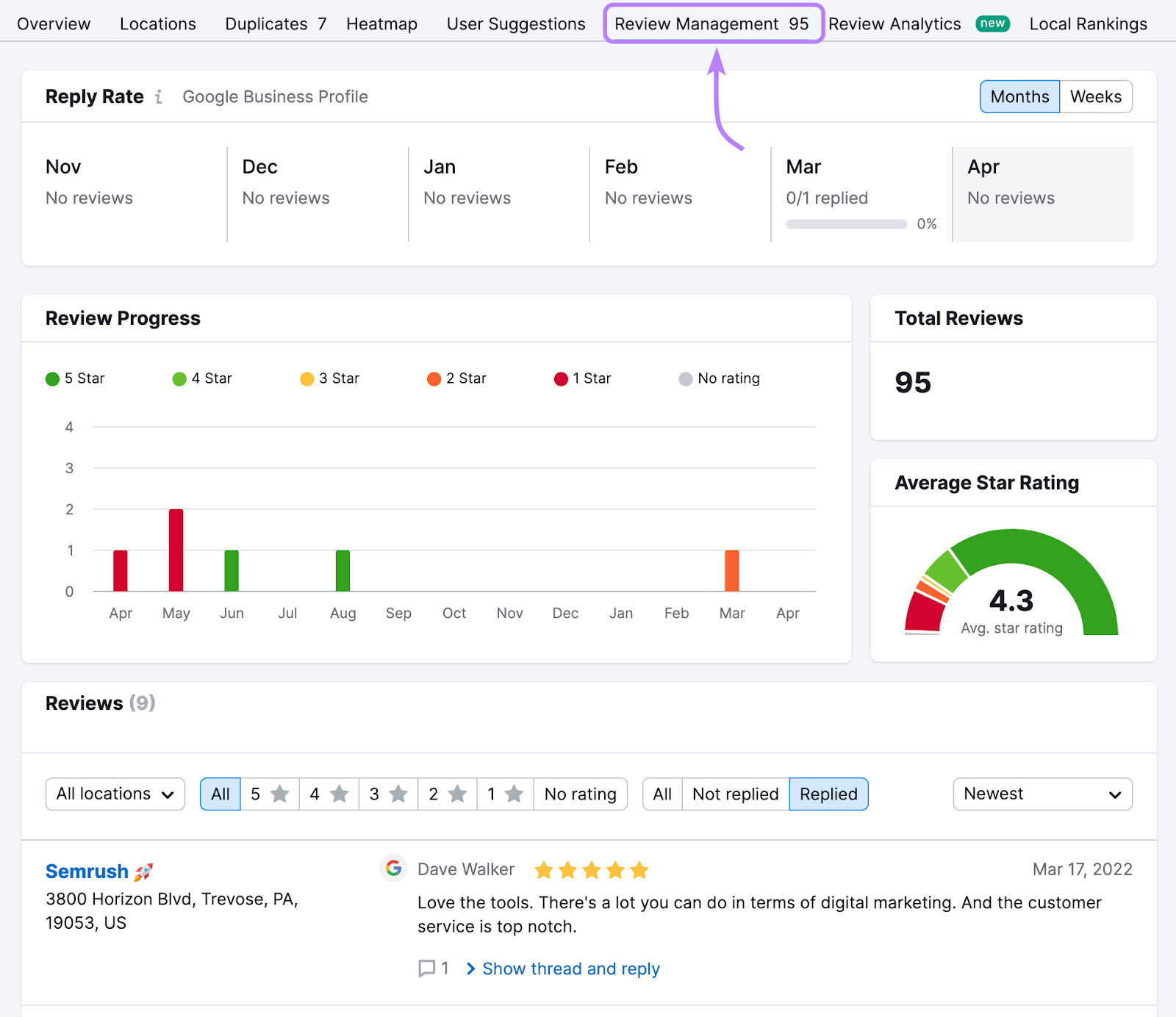
Plus, you can leverage AI-generated responses to unanswered reviews—handy inspiration for when you’re unsure how to reply.

9. Localize Your Email Marketing Efforts
Segment your email list by location to be able to send targeted marketing campaigns to specific geographic areas.
In other words, tailor your content to address local interests and concerns.
Why does it matter?
Well, because consumers value tailored communication. Global management consultants McKinsey found that 71% expect businesses to deliver personalized interactions. 76% get frustrated when that doesn’t happen.
See how creative agency Tux announced a new location in this marketing email:
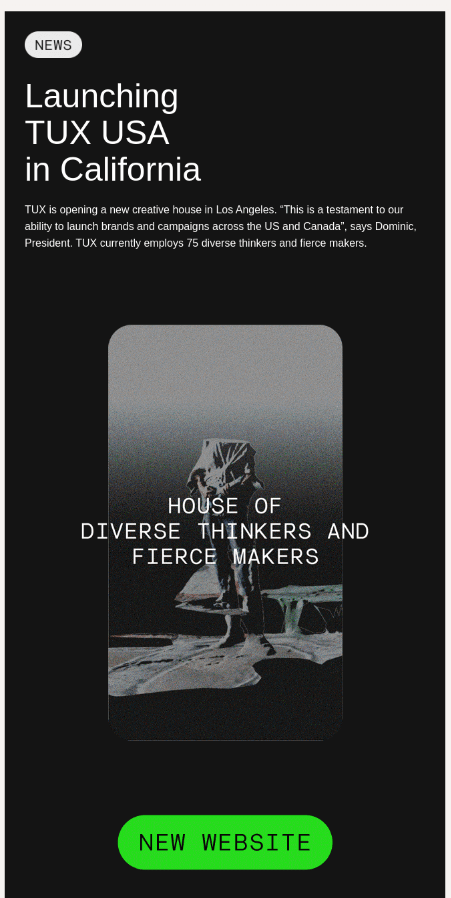
It likely segmented its email list by US region to ensure the message only reached people nearby. Geographic targeting like this often leads to higher open rates, more engagement, and a better email marketing return on investment (ROI).
Ask for subscribers’ locations when collecting email addresses for online marketing purposes. Then, store the data in email marketing or customer relationship management (CRM) software for easy segmentation.
If you run a brick-and-mortar store, offer digital receipts as an option—a simple way to collect local email addresses.
10. Collaborate with Other Local Businesses
Working with other local businesses can help you build brand awareness in your community.
Say you run an organic food store. You could collaborate with a local gym to offer each other’s customers discounts. Which would expose you to a new audience interested in health and wellness.
This type of collaborative referral program also shows your commitment to the local community (i.e., by supporting other small businesses). And further enhances your brand image.
For example, The Den martial arts school collaborated with sports equipment manufacturer Combat Corner on a referral program:
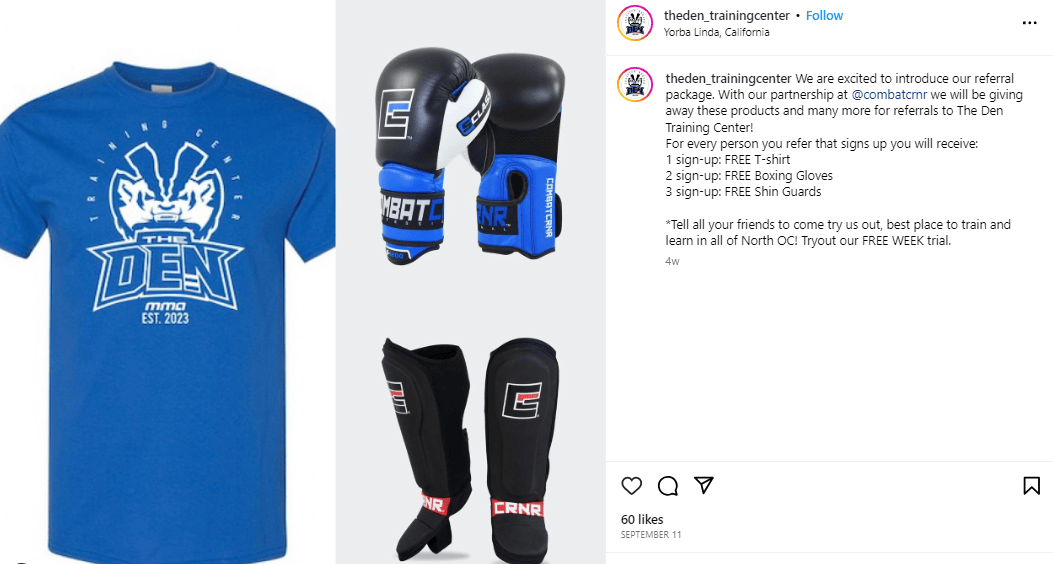
The collaboration process takes place in three steps:
- Identify and approach a business with whom you share values and target markets. Find your match at networking events, in online communities, and through word of mouth.
- Create a partnership agreement. Be clear on the promotional terms and benefits to safeguard your relationship.
- Publicize your collaborative efforts through social media, email marketing, and in-store signage. Encourage user-generated content (UGC) around promotions to expand your reach.
Once your partnership is up and running, track the results to see what works and what doesn’t.
The way you track may vary based on your partnership goals. Like whether you’re looking to increase each other’s social media followings. Or get more foot traffic to brick-and-mortar stores.
In any case, monitor current performance to help you fine-tune future efforts for bigger returns.
To attribute sales from partnerships accurately, use partner-specific discount codes and coupons.
You can track promotions using Urchin Tracking Module (UTM) codes, or small snippets of text added to the end of a URL.
Further reading: What Are UTM Codes: UTMs in Google Analytics & GA4
How can you localize your online advertising campaigns? By targeting specific geographic regions and demographics.
That’s a marketing technique called geofencing, which identifies potential prospects based on their exact location.
With geofencing marketing, you can:
- Ensure search engine and social media users in your local area (i.e., your ideal customers) see your messages
- Tailor ad content and maximize its relevance, increasing the likelihood of conversion
Observe how UK construction company Redrow Homes targets Instagram users in Cheshire with this ad promoting a new housing development:
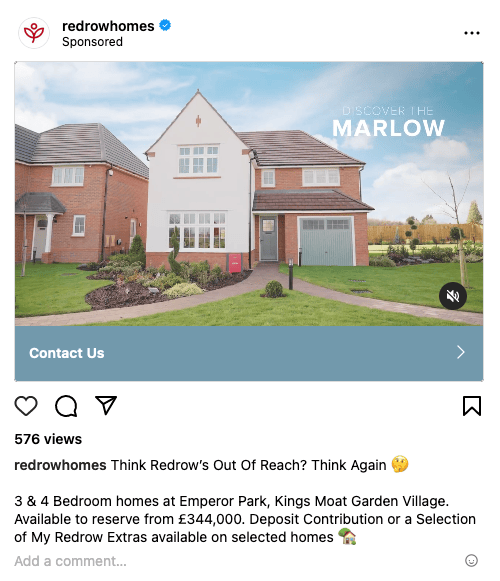
It knows the people who see it will be close to its development. And therefore more likely to take an interest than users outside of Cheshire.
Moreover, Redrow’s listing uses the area-specific terms “Emperor Park” and “Kings Moat Garden Village,” knowing these housing developments are relevant to its target audience. Thus making the content more personal and engaging.
Most major search and social ad platforms allow you to target users by location. Here’s what the option looks like on Google Ads:
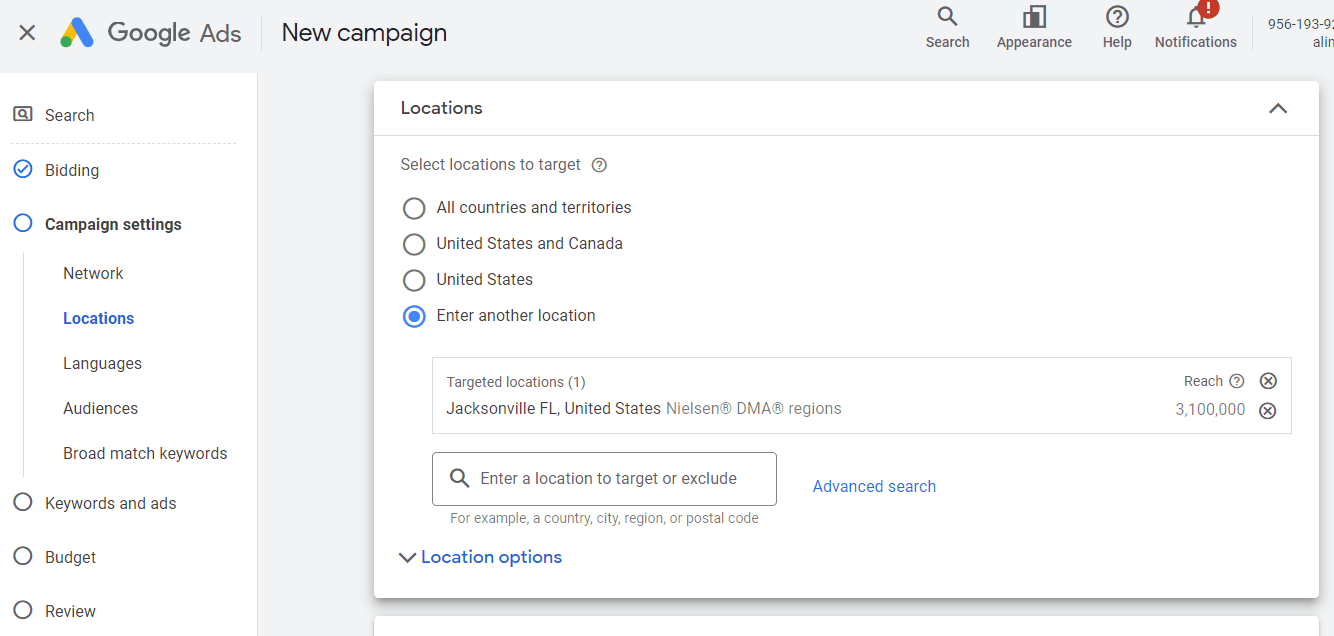
Image Source: KlientBoost
Remember: Ad channels rely on various signals to determine users’ locations. Including user settings and behavior, mobile devices, and IP addresses. These all vary, so it’s impossible to guarantee 100% accuracy.
Keep checking your broader performance metrics using the techniques outlined above to ensure your targeted marketing tactics are helping you meet your objectives.
Build Your Local Marketing Plan with Semrush
Local business marketing, like any other type of marketing, requires a mix of creativity, skill, data, and the right tools.
Semrush’s Listing Management will help your business get your products in front of prospective local customers. Check your local listings for free to get started.
Source link : Semrush.com
